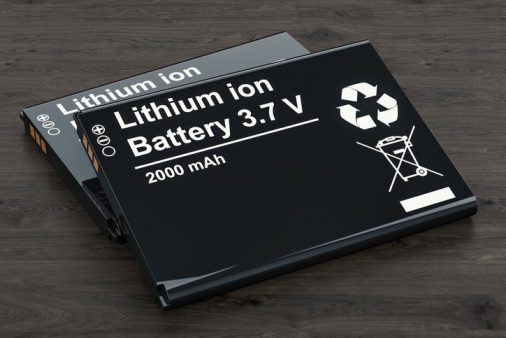Lithium-ion battery risks in Warehousing and Distribution

By QBE Senior Risk Manager Adrian Simmonds
Our never-ending quest for electronic gadgets has sparked a boom in the use of lithium-ion batteries.
Rechargeable lithium-ion (li-ion) batteries were first introduced in 1991. Today, they’re everywhere. Think about how many rechargeable devices are in your home or place of work - from the fitness tracker on your wrist, power tools in your workshop, your mobile phone, tablet and laptop.
With increasing demand for smaller, lighter and more powerful smart devices that hold their charge for longer, older battery technology is being replaced by li-ion.
As more and more devices and appliances are being developed, as well as the drive for electric cars, e-bikes and e-scooters, economic experts forecast that the global li-ion battery market size will more than double from $44.2 billion USD in 2020 to $94.4 billion USD by 2025.
Fire risk
In normal use, li-ion batteries are stable and work as intended with no problems. But if one catches fire, the results can be catastrophic.
A computer chip inside the battery is used to control the charge level. Under certain circumstances, such as if the battery has been damaged by dropping or piercing the device, a chemical reaction inside the battery can cause it to short circuit. This can cause the battery to severely overheat very quickly and go into ‘thermal runaway’, which can then lead to a fire.
It’s for this reason that organisations like the International Air Transport Association have very strict rules around the transportation of devices containing li-ion batteries.
Li-ion battery fires are very dangerous and can be difficult to deal with because they release a flammable and toxic vapour which helps to fuel the fire. Specially designed lithium battery fire extinguishers are available, based on a material called vermiculate. A Class B fire extinguisher (powder, foam, CO2) can also be used, though the risk of the fire reigniting is likely.
Li-ion batteries in industry
As a leading business insurer, we are all too aware of the risks that li-ion batteries can pose in commercial and industrial environments.
If we look at the waste recycling industry as an example, small fires are very common at recycling centres, in fact there’s one small fire every day on average. A report produced by the Environmental Services Association found that around 48% of waste fires in the UK each year are caused by li-ion batteries, with a cost to the UK economy of around £158 million.
The growth in li-ion battery use also brings increased risks for the businesses that store and distribute battery-powered products.
Retail sales in the UK have more than doubled over the last 30 years. And online sales are growing at a faster rate than in-store. A soaring rise in online shopping during the Covid-19 pandemic has driven major growth in the warehousing sector, with increases in both the number of warehousing units springing up throughout the UK, together with a trend towards much larger buildings to meet new demands. And many more of the products being stored and shipped out to customers by road, rail, air or sea contain li-ion batteries than ever before.
Warehousing and distribution
More warehouses storing more battery-powered products brings more risk. And alongside the products being stored, there is a range of rechargeable battery-powered hazards in running the warehouse itself. These include:
- Rugged tablets, barcode scanners and other operational hand-held devices
- Automated vehicles that self-park at charging stations
- Battery-powered fork lift trucks and charging stations in the storage areas, including hung on the ends of racks
The presence of li-ion batteries and the subsequent fire risk is something that should be addressed as part of fire protection and emergency response arrangements.
Whilst we can’t cover every aspect of risk management in this article, we would suggest that raising awareness of li-ion battery risks in a warehousing operation should include:
- A pre-defined Emergency Response Plan to tackle damaged or overheating li-ion batteries. This should be trained out to key employees BEFORE batteries are permitted on site.
- A pre-defined Hazard Control Plan to manage receiving, storage, despatch and supervision of packaged li-ion batteries. This should be trained out to key employees BEFORE batteries are permitted on site.
- Floor stacking of li-ion batteries should be strictly controlled in designated areas with limited stack heights, footprints and separation distances.
- Rack storage of li-ion batteries should not be permitted UNLESS the building and the racks are fully sprinklered with solid metal horizontal and vertical barriers between each storage bay.
- Extra vigilance should be adopted for product returns as the devices sent back from customers might arrive damaged and are often unpackaged so can suffer more physical impact during the returns transportation process.
- Infra-red thermography inspections using a hand-held IR gun should be done on each li-ion battery package on arrival and prior to despatch.
- Visual damage inspections and infra-red thermography inspections using a hand-held IR gun should be done to cover all li-ion battery stacks on a 3-4 hour frequency.
- ANY deviation from the normally expected general temperature by 3°C or more on any individual li-ion battery package should be reported to management immediately so the pre-defined emergency response action can be initiated.
- As a precautionary measure, a steel bin partially filled with water should be kept outdoors at least 3 metres clear of the building, ready for any packaged li-ion batteries with elevated temperatures to be placed into by fork lift truck. Other fire containment materials such as vermiculite or sand can be used to smother the affected battery. These measures might not stop the chemical fire from continuing, even under water, but they will assist with fire containment.
- Packages placed in such a bin should be left untouched by employees of the warehousing company. The supplier of the batteries should be called in to deal with the battery hazard on site and to remove it from site safely for further assessment.
Risk management services for QBE customers
QBE helps businesses build resilience through risk management and insurance.
Depending upon the size and complexity of the business needs, QBE customers can access a wide range of risk management services, self-assessment questionnaires and risk management toolkits which are focused on the key causes of claims, and on generating action plans for improved outcomes - including protecting employees, reducing risk and making claims less likely. You can find out more about how QBE helps businesses to manage risk here.
Need to claim? Report it early
Finally, a reminder that if you have an incident and need to make an insurance claim, it’s important that you report it as soon as possible, ideally the same day. Reporting a claim early can save time and help you to receive any claim payments faster, as well as allowing us to help mitigate the cost of third-party claims.
Downloads
About QBE
QBE European Operations is part of QBE Insurance Group, one of the world’s leading international insurers and reinsurers and Standard & Poor’s A+ rated. Listed on the Australian Securities Exchange, QBE’s gross written premium for the year ended 31 December 2018 was US$13.7 billion.
As a business insurance specialist, QBE European Operations offers a range of insurance products from the standard suite of property, casualty and motor to the specialist financial lines, marine and energy. All are tailored to the individual needs of our small, medium and large client base.
We understand the crucial role that effective risk management plays in all organisations and work hard to understand our clients’ businesses so that we offer insurance solutions that meet their needs – from complex programmes to simpler e-trading solutions – and support them in minimising their risk exposures. Our expert risk management and rehabilitation practitioners focus on helping clients improve their risk management so that they may benefit from a reduction in claims frequency and costs.

